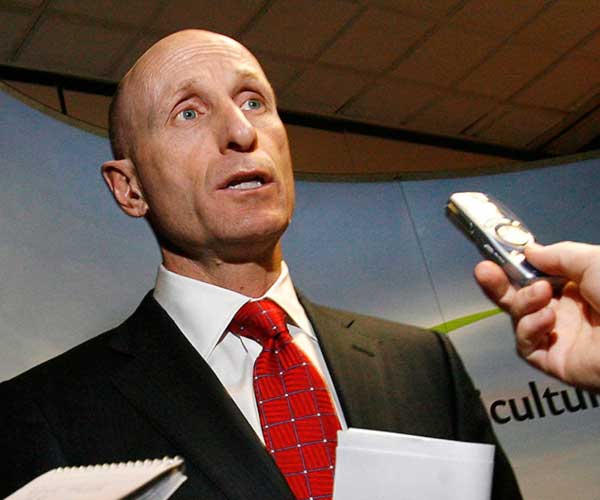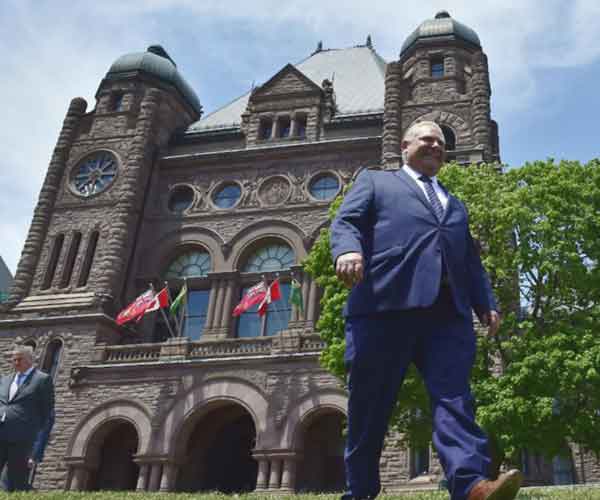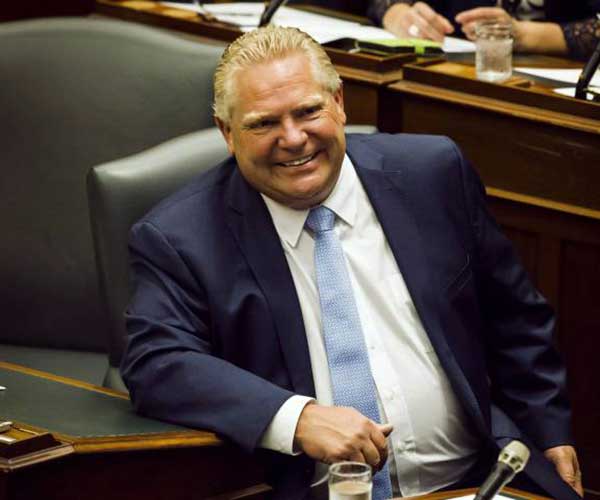The new Ford government has set in motion a string of high profile moves on Ontario’s electricity system. These included the ouster of Hydro One CEO Mayo Schmidt and the subsequent resignation of the remainder of the utility’s board, along with the announcement of the cancellation of 758 renewable energy projects.
The government also specifically targeted the 18.5-megawatt White Pines wind power project in Prince Edward County for termination in its July 12 Speech from the Throne.
These moves come on top of the government’s repeated statements of its intention to terminate the province’s cap and trade system for greenhouse gases, end subsidies for electric vehicles, and cancel GreenON support for home energy efficiency retrofits.
The government’s intent behind these moves, as stated in its Throne Speech, is to “lower electricity bills.” Whether the government’s actions will have any significant effect on electricity costs remains an open question at best.

Mayo Schmidt, former CEO of Hydro One, talks to media /Archive Photo by THE CANADIAN PRESS
The specific merits of Hydro One now ex-CEO Schmidt’s $6 million/yr pay notwithstanding, executive compensation in the Ontario electricity system constitutes a tiny portion of overall costs, amounting to pennies per month on the average residential hydro bill.
The recently announced renewable energy project cancellations were relatively small and represented the province’s last round of intended renewable energy procurements. The costs of the litigation flowing from their cancellations may far exceed whatever amount the province thought it might save.
The proponent of the White Pines project has already signaled its intention to seek $100 million in damages as a result of the government’s actions. Echoes of the gas plant cancellation scandal that destroyed Dalton McGuinty’s premiership loom large already.
The government appears to believe that it can protect itself from such lawsuits through legislation. That remains to be seen, although provincial legislation will do nothing to shield the province from actions by investors from countries which have signed trade agreements with Canada including provisions, like NAFTA’s notorious Chapter 11, allowing investors to seek compensation from host countries that take actions that damage the value of their investments.
Canada has entered into dozens of such agreements over the past two decades.
At the same time, the new government remains steadfast in its obstinate refusal to examine what was identified, within the previous government’s Long-Term Energy Plan, as the key drivers of future increases in electricity costs in Ontario: namely the planned refurbishments of the Darlington and Bruce nuclear power plants; and the proposed, and potentially perilous, “life-extension” of the already aged Pickering facility. The Liberal’s plan foresaw hydro rate increases in excess of 50 percent over the next twenty years, in large part due to these projects.

The attack on solar energy impacting high hydro costs or Ontario’s electricity costs has been relentless by some media outlets. But do they have a point? /Graham Hughes/Canadian Press
The government’s approach carries with it other major risks. The government’s moves have been sending very clear signals that Ontario may not be a stable location for major energy investments.
More specifically, the government’s energy strategy, such as it is, seems to be specifically targeting technological developments that are widely seen as constituting the leading edge in the evolution of the energy sector globally.
These include renewable energy technologies, whose technical and economic performance has improved dramatically over the past decade towards near parity with conventional energy sources; energy storage, central to the growing adoption of electric and hybrid-electric vehicles, advanced electronics, and the modernization of electricity systems; and smart grids, allowing the integration of distributed, and potentially more reliable, cost-effective, and resilient energy sources. In effect, Ontario seems to be announcing that it has no interest in being part of those developments.

Premier Doug Ford on the lawn of the Ontario legislature on Friday, June 8, 2018. / THE CANADIAN PRESS
If the Ford government is serious about reducing electricity costs in the long term, the most sensible course would be to pause and take stock of the full range of options available to the province in terms of meeting its future electricity needs. These options need to not only include nuclear refurbishments but also importing electricity from Quebec, conservation initiatives and adding more renewable energy to the grid.
The province should then choose its path forward based on which options offer the lowest long-term economic and environmental costs and risks, and the greatest flexibility to respond to changing economic and environmental conditions.
Whether the Ford government can move beyond its current fixation on dismantling the previous government’s climate change strategy, and its apparently profound loathing of anything to do with renewable energy, to articulate a viable energy and hydro strategy that will actually protect Ontario consumers from future cost increases remains to be seen.
—
This article is written by Mark Winfield, PhD for pvbuzz.com. It is edited by Derick Lila.
 Mark Winfield, Professor Co-Chair, Sustainable Energy Initiative (SEI) & MES/JD Coordinator Sustainable Energy Certificate Coordinator[/caption]Mark Winfield is a Professor of Environmental Studies at York University. He is also Co-Chair of the Faculty’s Sustainable Energy Initiative, and Coordinator of the Joint Master of Environmental Studies/Juris Doctor program offered in conjunction with Osgoode Hall Law School.
Mark Winfield, Professor Co-Chair, Sustainable Energy Initiative (SEI) & MES/JD Coordinator Sustainable Energy Certificate Coordinator[/caption]Mark Winfield is a Professor of Environmental Studies at York University. He is also Co-Chair of the Faculty’s Sustainable Energy Initiative, and Coordinator of the Joint Master of Environmental Studies/Juris Doctor program offered in conjunction with Osgoode Hall Law School.














Comments